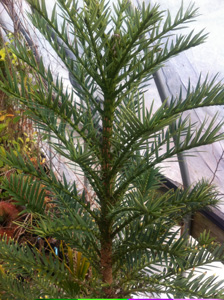Resource Library
Plant of the Week: Wollemi Pine
The University of Arkansas System Division of Agriculture does not promote, support or recommend plants featured in "Plant of the Week." Please consult your local Extension office for plants suitable for your region.
Plant of the Week
Wollemi Pine
Latin: Wollemia nobilis

The concept of living fossils – those plants that have a very long lineage and an abundant fossil record over a large geographic area – have always intrigued me. There are actually quite a few of them, including ginkgo, cycads, dawn redwood, bald cypress and Norfolk Island pine, just to name a few. So when a new living fossil is found, it is not surprising a lot of interest is generated, as recently happened with the Wollemi Pine (Wollemia nobilis).
The Wollemi pine was discovered growing in a deep, almost inaccessible sandstone canyon in Australia’s Wollemi National Park, about 125 miles northwest of Sydney. David Noble, for whom the species is named, repelled into the declivity in 1994 and bushwhacked along the stream at the base of the canyon until he spotted a tree he did not recognize. Returning with specimens in hand, it was described as a new monotypic genus in the Norfolk Island pine family the next year. In the wild, the species is found in three closely spaced stands, with 39 mature trees and about 200 smaller seedling trees.
This evergreen grows to 125 feet tall with a 15 foot spread. Most of the mature trees form coppice stands (multiple trunks arising from existing trunks) with unbranched main trunks. The bark on mature trees is described as looking like puffed rice cereal. The leaves are flat, pointed at the tip and to 2 inches long and one quarter-inch wide, and arranged along the branches in flattened rows. On mature plants, male or female cones are produced at the ends of the lateral branches.
Wollemi – an aboriginal word that means “watch your step” or “watch out” – pine fossils have been found in extant parts of the ancient supercontinent Gondwanaland in areas of Australia, New Zealand and even Antarctica. Wollemia nobilis appears to have branched from the main trunk of the Norfolk Island pine family tree between 95 and 110 million years ago. The youngest known fossil is about 2 million years old, at which time it was presumed to have gone extinct.
Conservation efforts to preserve the species have taken two tracks. First, the location of the stand is a closely held secret and unauthorized visits are not allowed, especially since 2005 —one of the trees died that year, when a root rot fungus was probably introduced into the site on the boots of a visitor. Secondly, the Australian parks people decided to collect seeds and make the tree generally available for botanical gardens and gardeners throughout the world. Though propagating a plant to preserve it seems common sense, such is not always the case with some critically endangered species. The first general introduction of the Wollemi pine in the United States was by the National Geographic Society in 2006. Since then, cutting-grown plants are being produced by several West Coast nurseries.
The species is generally considered more hardy than was first thought, with plants surviving 10ºF temperatures in the winter and summertime temperatures higher thanr 100ºF. Though found in a very wet location, the Wollemi pine seems to tolerate typical garden soil and moisture conditions. Stan Brown, the proprietor of Blossomberry Nursery in Clarksville, has the only specimen I’ve seen in Arkansas, and he keeps his one plant in his cold greenhouse with other plants that are subject to winter burn. It seems to be easy to grow as a container plant, or if you live in South Arkansas, might be worth trying in a sheltered, south-facing location in the landscape. It will probably have a zone of adaptation similar to Araucaria bidwilli, the monkey puzzle tree, which is the most cold-hardy of the Norfolk Island pine relatives.
By: Gerald Klingaman, retired
Retired Extension Horticulturist - Ornamentals
Extension News - March 2, 2012
The University of Arkansas System Division of Agriculture does not maintain lists of retail outlets where these plants can be purchased. Please check your local nursery or other retail outlets to ask about the availability of these plants for your growing area.